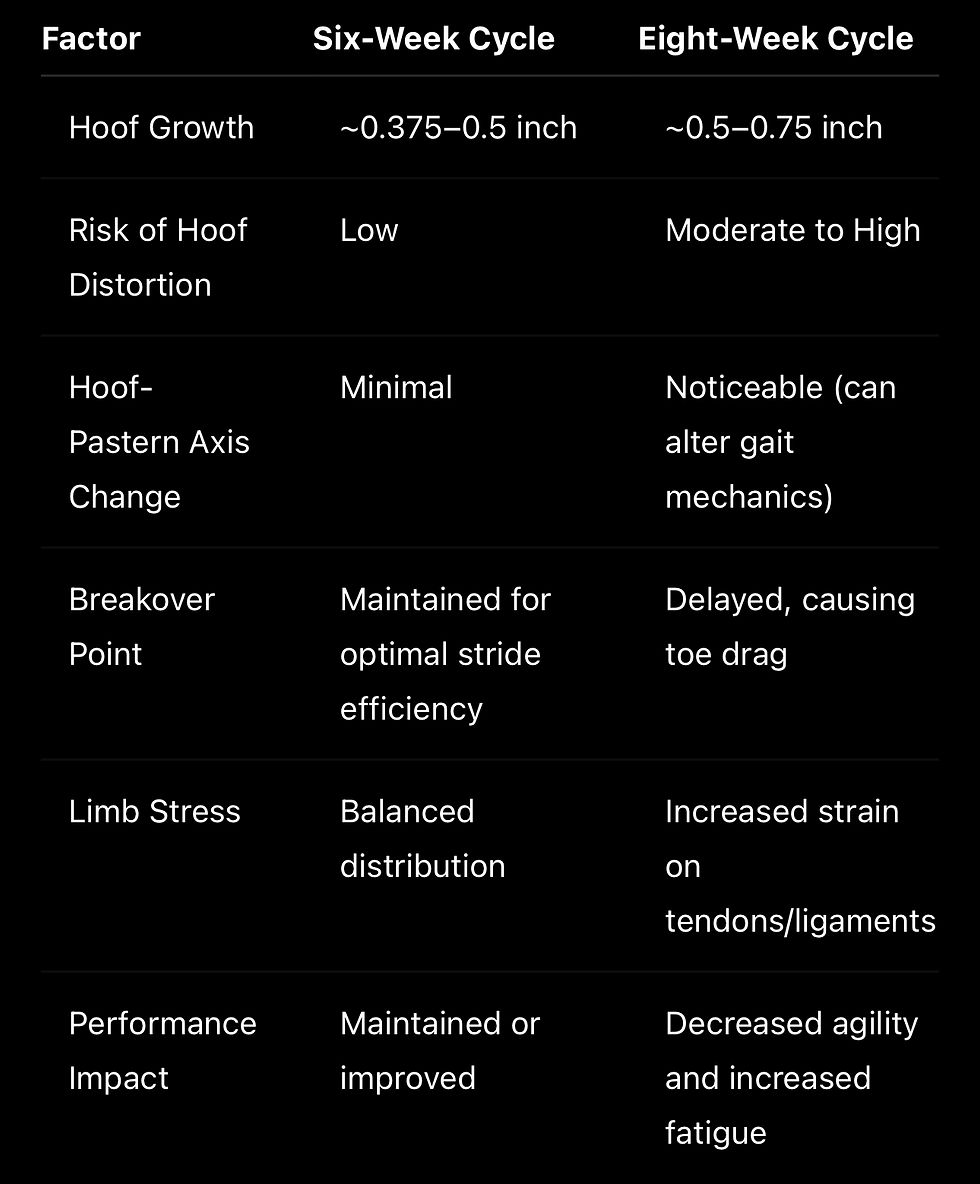
Step Ahead: Why a Six-Week Shoeing Cycle is Best for Your Horse's Health and Performance.
- Rocking Speer Ranch, LLP Farrier Services

- Jul 27
- 3 min read
The maintenance of a horse's hooves is not just a matter of aesthetics or routine care; it's a cornerstone of equine health and performance. Among professional farriers and equine veterinarians, a six-week shoeing or trimming cycle is widely recognized as optimal for maintaining hoof balance, supporting sound locomotion, and preventing injury. While some horse owners may stretch cycles to eight weeks or more for convenience or cost, science and biomechanics strongly support a more frequent schedule for long-term health and athletic performance.
Understanding Hoof Growth and Mechanics
A horse's hoof grows on average 1/4 to 3/8 of an inch per month, influenced by factors like age, nutrition, activity level, and environment.[1] Over six weeks, this amounts to roughly half an inch of growth—enough to significantly alter the biomechanics of the limb if left unaddressed. The longer hooves grow without maintenance, the more the angles of the hoof-pastern axis change, which can cause altered stride, toe-first landing, joint stress, and even soft tissue strain.
Dr. Debra Taylor, DVM, emphasizes, "Even subtle changes in hoof angle and limb balance can result in mechanical imbalances that predispose the horse to lameness and decreased performance."[2]
Six vs. Eight Weeks: The Critical Difference
While eight-week cycles may appear sufficient for horses in light work or pasture environments, performance horses, horses with prior hoof issues, or those in regular training benefit markedly from the six-week schedule. Here's how the differences manifest:

Biomechanical studies confirm that as hoof length increases, the breakover point (the moment the hoof leaves the ground) is delayed, placing excess stress on the deep digital flexor tendon and suspensory apparatus. Over time, this can lead to inflammation, soreness, and eventual injury.[3]
Real-World Application and Farrier Insights
Professional farriers often see firsthand the mechanical effects of elongated cycles. According to farrier and equine educator Esco Buff, PhD, APF-I, "The longer you wait, the more mechanical leverage works against the horse's natural stride. Six weeks allows the farrier to intervene before those issues cause cascading problems."[4]
Furthermore, a study published in the Journal of Equine Veterinary Science found that sport horses on six-week shoeing intervals maintained more consistent stride length, joint symmetry, and ground contact timing compared to those on eight-week cycles.[5] This is especially important for disciplines like barrel racing, jumping, and dressage where precision and limb control are critical.
Hoof Balance and Soundness
Correct hoof balance, a primary goal of the six-week cycle, plays a pivotal role in minimizing concussion and promoting longevity. Horseshoeing too infrequently allows flares, wall separation, and mismatched hoof angles to develop, all of which can cause uneven wear on joints and compensatory movement.
Farriers also report that horses regularly maintained on a six-week schedule are easier to keep balanced, require less corrective work over time, and exhibit fewer instances of lameness related to hoof imbalance.
Conclusion
A six-week shoeing or trimming cycle is not just a matter of best practice; it's a proactive health measure backed by biomechanics, veterinary guidance, and decades of field experience. While some horses may tolerate an eight-week interval without immediate issues, consistent six-week maintenance offers measurable advantages in performance, limb health, and overall soundness. For owners seeking to optimize their horse’s athletic potential and prevent injury, the six-week cycle remains the gold standard.
References
Stashak, T. S. (2002). Adams' Lameness in Horses, 5th Edition. Lippincott Williams & Wilkins.
Taylor, D. (2015). "Evaluating Hoof-Pastern Axis and Its Role in Performance Horses." AAEP Proceedings.
Clayton, H. M., & Hobbs, S. J. (2017). "Biomechanics of the equine limb: Implications for performance and injury." Veterinary Clinics: Equine Practice.
Buff, E. (2020). "Hoof Balance: Maintenance, Mechanics, and Misconceptions." American Farriers Journal.
Walters, J. M., et al. (2018). "Effect of Farriery Intervals on Kinematic Parameters in Performance Horses." Journal of Equine Veterinary Science, 66: 34-40.



Comments